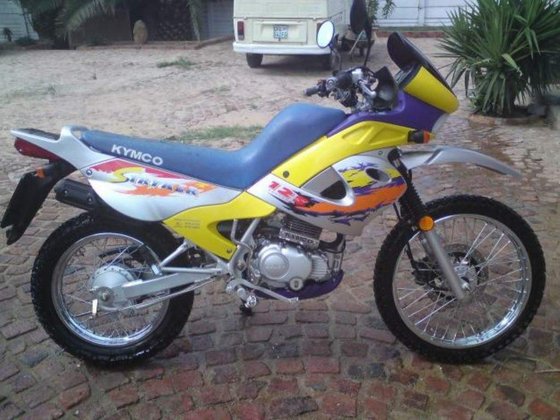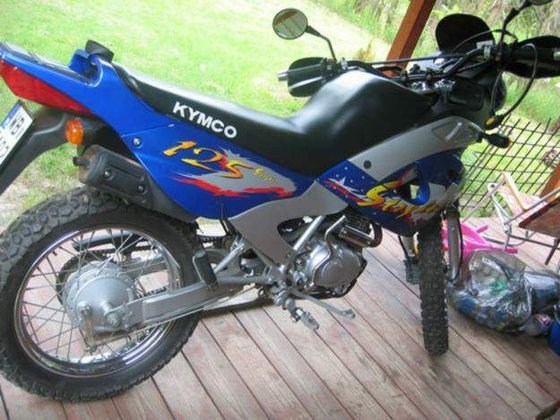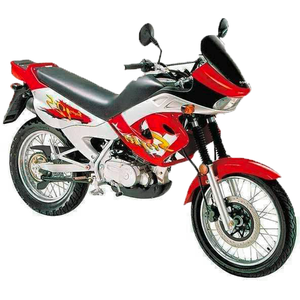KYMCO STRYKER 125 [2000 - 2007]: The Underdog of Versatile Riding

Introduction
The KYMCO STRYKER 125, produced from 2000 to 2007, remains a fascinating study in balancing practicality and adventure. Designed to straddle multiple categories—sport, enduro, and all-rounder—this motorcycle carved a niche for riders seeking a jack-of-all-trades machine. With its rugged simplicity and approachable power delivery, the Stryker 125 appeals to both urban commuters and weekend trail explorers. After spending time with this machine, it’s clear why it developed a cult following in its heyday. Let’s dive into what makes this generation of the Stryker a hidden gem.
Design & Ergonomics

The Stryker 125’s design leans into its dual-purpose DNA. With an overall length of 2,120 mm (83.5 inches) and a dry weight of 142 kg (313 lbs), it’s neither too bulky for city traffic nor too delicate for light off-roading. The seat height—ranging from 840–905 mm (33.1–35.6 inches)—strikes a balance between accessibility for shorter riders and ground clearance for uneven terrain.
The tubular steel frame gives the bike a no-nonsense, utilitarian aesthetic. Off-road variants feature a 90/90-21 front tire (34.6-inch width) for better obstacle negotiation, while on-road models use a slightly narrower 90/90-18 front tire. The upright riding position, wide handlebars, and neutral footpeg placement ensure comfort during long rides. Despite its plastic-heavy body panels, the Stryker feels robust, though aftermarket upgrades (like skid plates) are recommended for aggressive trail use.
Engine & Performance
At the heart of the Stryker lies an air-cooled, single-cylinder, four-stroke engine. The 124.1 cc (7.57 cubic inches) displacement delivers modest outputs: 10.3 HP (7.5 kW) @ 8,500 RPM and 8.9 Nm (6.6 lb-ft) of torque @ 7,500 RPM. While these numbers won’t set any speed records, the engine’s linear powerband and carbureted fueling make it forgiving for beginners.
The 5-speed gearbox is a highlight. Shifts are crisp, and the ratios are well-spaced for both low-speed crawling and highway cruising. Top speed hovers around 100 km/h (62 mph), though maintaining 80–90 km/h (50–56 mph) feels more natural. The engine’s air cooling keeps things simple, but prolonged high-RPM runs in hot climates can lead to noticeable heat soak. For riders prioritizing reliability over thrills, this mill is a workhorse.
Handling & Ride Experience
KYMCO nailed the Stryker’s suspension setup for its intended use. The 210 mm (8.3 inches) of front wheel travel from the hydraulic forks and 200 mm (7.9 inches) at the rear absorb potholes and trail debris with ease. On pavement, the bike feels stable at speed, though the 17-inch rear tire (130/80-17) and narrow front profile demand deliberate countersteering in corners.
Off-road, the Stryker shines. The 21-inch front wheel (on off-road variants) rolls over rocks and ruts confidently, while the 142 kg (313 lbs) weight is manageable when standing on the pegs. Braking is adequate but not stellar: the front 276 mm single disc provides decent bite, but the rear 140 mm drum brake requires planning ahead. Swapping to sintered pads and a high-quality brake fluid (DOT 4) improves stopping power noticeably.
Competition
In the 125cc dual-sport segment, the Stryker faced stiff competition:
- Honda XL125 Varadero: Honda’s offering had a slightly more refined engine and better suspension components but weighed 15 kg (33 lbs) more, blunting its off-road agility.
- Yamaha TW125: Known for its bulletproof reliability and iconic fat-tire look, the TW125 traded horsepower for low-end torque, making it better for technical trails but slower on asphalt.
- Suzuki DR125: A closer match in specs, the DR125 edged ahead with its oil-cooled engine and lighter frame but lacked the Stryker’s parts availability and affordability.
Where the Stryker stood out was in its balance of cost, simplicity, and adaptability. While rivals excelled in specific areas, the KYMCO offered a compelling package for riders who wanted one bike to handle commuting, light touring, and weekend dirt adventures.
Maintenance
The Stryker 125’s maintenance needs are straightforward, but attention to detail pays dividends in longevity:
Key Considerations:
- Valve Adjustments: With a 0.10 mm (0.004 in) clearance for both intake and exhaust valves, checks every 3,000 km (1,864 miles) are critical. Neglect here leads to noisy operation and power loss.
- Oil Changes: Use SAE 10W-40 motorcycle oil, replacing 1.0 liter (1.06 quarts) with the filter. The air-cooled engine thrives on fresh oil, especially after dusty off-road rides.
- Carburetor Tuning: The stock 1.5 turns out on the air screw is a safe baseline, but altitude and temperature changes may require fine-tuning. A carb rebuild kit from MOTOPARTS.store can restore responsiveness.
- Chain & Sprockets: The 16/39 sprocket combo prioritizes acceleration over top speed. A quality O-ring chain reduces stretch and maintenance intervals.
- Tire Pressures: Stick to 1.8–2.0 bar (26–29 psi) front and 2.2–2.5 bar (32–36 psi) rear for mixed-use riding.
Common Upgrades:
- LED Lighting: Boost visibility with plug-and-play LED bulbs.
- Aftermarket Exhaust: A free-flowing slip-on (with rejetting) unlocks a hint of extra torque.
- Upgraded Suspension: Heavier fork oil and a preload-adjustable rear shock transform rough-terrain handling.
Conclusion
The KYMCO STRYKER 125 isn’t about raw power or cutting-edge tech—it’s about freedom. Freedom to carve city streets, tackle fire roads, or simply enjoy the mechanical purity of a no-frills motorcycle. Its durability and ease of repair make it a favorite for DIY enthusiasts, while its modest running costs appeal to budget-conscious riders.
Today, the Stryker 125 remains a testament to KYMCO’s pragmatic engineering. Whether you’re reviving a barn find or optimizing a well-loved example, MOTOPARTS.store has the components to keep your Stryker running—and grinning—for years to come.
Ride safe, explore often, and remember: adventure isn’t about the bike’s size, but the size of your curiosity.
Specifications sheet
| Engine | |
|---|---|
| Stroke: | Four-stroke |
| Ignition: | CDI |
| Max power: | 8 kW | 11.0 hp |
| Max torque: | 8.9 Nm |
| Fuel system: | Carburetor |
| Max power @: | 8500 rpm |
| Displacement: | 125 ccm |
| Max torque @: | 7500 rpm |
| Bore x stroke: | 57.0 x 48.8 mm (2.2 x 1.9 in) |
| Configuration: | Single |
| Cooling system: | Air |
| Compression ratio: | 9.2:1 |
| Number of cylinders: | 1 |
| Dimensions | |
|---|---|
| Wheelbase: | 1390 mm (54.7 in) |
| Dry weight: | 142 |
| Seat height: | 850 mm (33.5 in) |
| Overall width: | 880 mm (34.6 in) |
| Overall height: | 1300 mm (51.2 in) |
| Overall length: | 2120 mm (83.5 in) |
| Fuel tank capacity: | 14 L (3.7 US gal) |
| Drivetrain | |
|---|---|
| Final drive: | chain |
| Transmission: | 5-speed |
| Rear sprocket: | 39 |
| Front sprocket: | 16 |
| Maintainance | |
|---|---|
| Rear tire: | 130/80-17 |
| Engine oil: | 10W40 |
| Front tire: | 90/90-18 |
| Break fluid: | DOT 4 |
| Spark plugs: | NGK DR8EA or NGK DR8EIX |
| Spark plug gap: | 0.7 |
| Coolant capacity: | N/A (Air-cooled) |
| Forks oil capacity: | 0.4 |
| Engine oil capacity: | 1.0 |
| Valve clearance (intake, cold): | 0.10 mm |
| Valve clearance (exhaust, cold): | 0.10 mm |
| Recommended tire pressure (rear): | 2.2–2.5 bar (32–36 psi) |
| Recommended tire pressure (front): | 1.8–2.0 bar (26–29 psi) |
| Chassis and Suspension | |
|---|---|
| Frame: | Tubular steel |
| Rear brakes: | 140 mm drum |
| Front brakes: | Single 276 mm disc |
| Rear suspension: | Hydraulic single shock |
| Front suspension: | Hydraulic fork |
| Rear wheel travel: | 200 mm (7.9 in) |
| Front wheel travel: | 210 mm (8.3 in) |



















